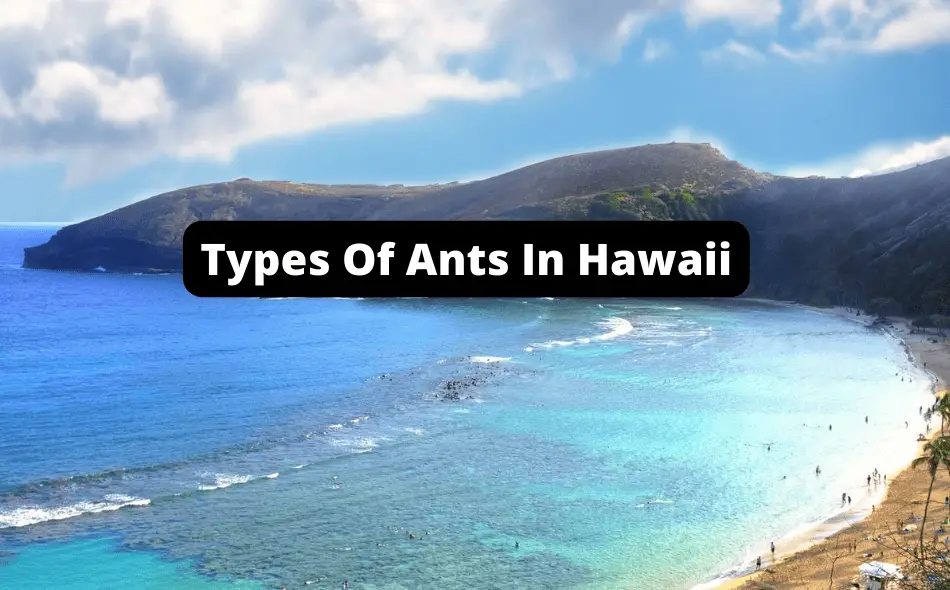Hawaii, a group of islands located in the Pacific Ocean, is known for its stunning natural beauty and unique ecosystem. The region is a part of the United States and is situated in the North Pacific Ocean, approximately 2,000 miles southwest of the mainland.
The islands are home to a diverse range of flora and fauna, including rare and endangered species found nowhere else in the world. The tropical climate of Hawaii is characterized by warm temperatures, high humidity, and frequent rainfall, making it an ideal environment for lush vegetation and thriving wildlife.
From the majestic humpback whales that migrate to the islands each year to the colorful birds that flit through the forests, Hawaii is a haven for nature lovers and outdoor enthusiasts alike. .
Types Of Ants In Hawaii
The Types Of Ants In Hawaii are listed here: Carpenter And Sugar Ants, Acrobat Ants, Crypt Ants, Trailing Pharaoh And Timid Ants, Crazy Ants, Crazy Ants, Porthole Ants, Vampire Ants, Miniature Trap-Jaw Ants, Tapinoma, Rover Ants, Emerys Sneaking Ants, Sneaking Ants, Sneaking Ants, Sneaking Ants, Crypt Ants, Crypt Ants, Urban Alate Ants, Crypt Ants, Black Garden Ants, Trailing Pharaoh And Timid Ants, Pharaoh Ants, Crazy Ants, Ochetellus Glaber, Longhorn Crazy Ants, Big Headed Ants, Restless Ants, Tropical Fire Ants, Miniature Trap-Jaw Ants, Pale-Footed Ants, Pale-Footed Ants, Pavement Ants, Groove-Headed Fierce Ants, Singapore Ants.
If you’ve found some other ants in this region, contact us, and we will add them to the list!
1) Carpenter And Sugar Ants, Camponotus

Carpenter ants and sugar ants are two common species of ants found in many regions of the world.
Carpenter ants are known for their ability to excavate wood and create nests within it.
They are typically larger in size than sugar ants and have a black or dark brown coloration.
Carpenter ants are also known for their strong mandibles, which they use to chew through wood and other materials.
Sugar ants, on the other hand, are smaller in size and have a yellow or brown coloration.
They are named for their preference for sugary foods and are often found in kitchens and other areas where food is stored.
Sugar ants are also known for their ability to form large colonies, with thousands of individual ants working together to gather food and care for their young.
Both carpenter ants and sugar ants play important roles in their ecosystems.
Carpenter ants help to break down dead wood and other plant material, which helps to recycle nutrients back into the soil.
Sugar ants help to disperse seeds and pollinate plants, which helps to maintain healthy ecosystems.
However, both species can also be pests when they invade human homes and buildings.
Carpenter ants can cause damage to wooden structures, while sugar ants can contaminate food and be a nuisance to homeowners.
It is important to take steps to prevent ant infestations and to control them if they do occur, in order to protect both human health and the health of the environment.
2) Acrobat Ants, Crematogaster

Acrobat ants, also known as Crematogaster spp., are a genus of ants that are found in various parts of the world.
These ants are known for their unique ability to contort their bodies and move in acrobatic ways, hence their name.
Acrobat ants are relatively small, with workers measuring between 2-5mm in length.
They are typically brown or black in color, with a slender body and long legs.
These ants are known for their aggressive behavior and will readily defend their nests against intruders.
One of the most interesting features of acrobat ants is their ability to use their mandibles to grip onto surfaces and contort their bodies in unusual ways.
This allows them to move along narrow branches, twigs, and other surfaces that would be difficult for other ants to navigate.
They are also able to use this ability to escape from predators, such as birds and other insects.
Acrobat ants are omnivorous, meaning that they will eat both plant and animal matter.
They are known to feed on insects, nectar, and honeydew, as well as fruits and seeds.
These ants are also known to tend to aphids, protecting them from predators in exchange for the sweet honeydew that the aphids produce.
In terms of their social structure, acrobat ants are typically organized into colonies that are led by a queen.
The queen is responsible for laying eggs, while the workers are responsible for foraging, caring for the young, and defending the nest.
Overall, acrobat ants are fascinating creatures that have adapted unique abilities to survive in their environments.
Their acrobatic abilities and aggressive behavior make them a formidable force in the insect world.
3) Crypt Ants, Hypoponera
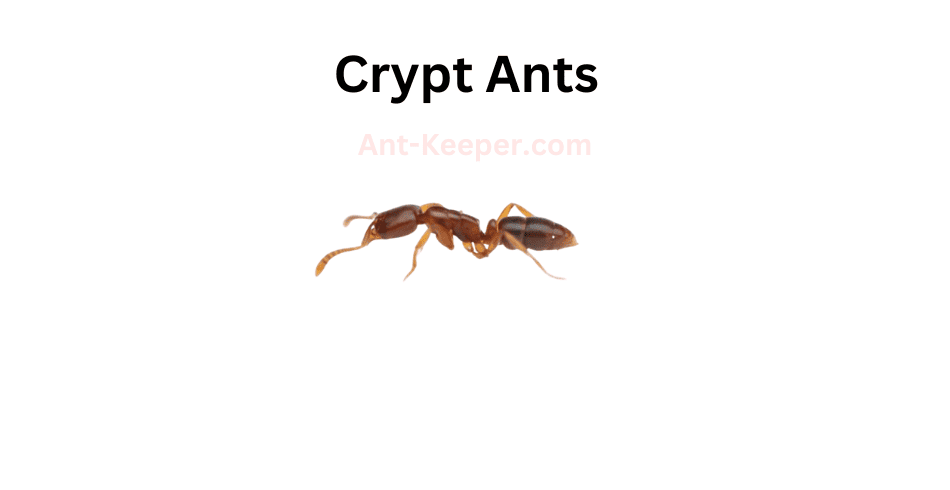
Crypt ants, also known as fungus-growing ants, are a group of ants that cultivate fungi for food.
They are found in various habitats, including forests, grasslands, and deserts.
Crypt ants are known for their unique nesting behavior, as they construct underground chambers to house their fungal gardens.
These ants have a symbiotic relationship with the fungi they cultivate.
The ants provide the fungi with a suitable environment for growth, while the fungi provide the ants with a source of food.
The ants also protect their fungal gardens from other insects and parasites.
Crypt ants are social insects, living in colonies that can range from a few dozen to several thousand individuals.
The colonies are organized into castes, with the queen being the largest and most important member.
The queen is responsible for laying eggs, while the workers are responsible for tending to the fungal gardens and caring for the young.
One interesting aspect of crypt ants is their ability to create "satellite" nests.
These nests are smaller chambers located near the main nest, and they serve as storage areas for food and as a place for the queen to lay eggs.
The satellite nests are connected to the main nest by underground tunnels, allowing the ants to move between them.
Overall, crypt ants are fascinating insects that have developed a unique way of obtaining food.
Their symbiotic relationship with fungi and their complex nesting behavior make them an important species to study in the field of entomology.
4) Trailing Pharaoh And Timid Ants, Monomorium

The Trailing Pharaoh ant, also known as the Monomorium pharaonis, is a small, reddish-brown ant species that is commonly found in urban areas.
These ants are known for their ability to form large colonies, which can consist of thousands of individuals.
One interesting behavior of the Trailing Pharaoh ant is their tendency to trail behind other ants.
This behavior is thought to be a form of communication, as the trailing ants are able to follow the scent trail left by the leading ants.
This behavior is also used to locate food sources, as the trailing ants are able to follow the trail to the source of the food.
In contrast to the bold behavior of the Trailing Pharaoh ant, the Timid ant, also known as the Temnothorax species, is a much more cautious species.
These ants are small and brown, and are often found in wooded areas.
They are known for their timid behavior, and will often retreat into their nests when threatened.
Despite their timid nature, the Timid ant is still able to form large colonies.
They are also known for their ability to adapt to changing environments, and can be found in a variety of habitats, including forests, meadows, and even urban areas.
Overall, both the Trailing Pharaoh ant and the Timid ant are fascinating species that demonstrate unique behaviors and adaptations.
By studying these ants, scientists can gain a better understanding of the complex social behaviors and ecological roles of ants in their respective environments.
5) Crazy Ants, Nylanderia

Crazy ants, also known as Nylanderia fulva, are a species of ant that belong to the family Formicidae.
They are small in size, measuring only about 2.2 to 3 mm in length, and are reddish-brown in color.
These ants are known for their erratic and unpredictable behavior, hence the name "crazy ants."
Crazy ants are native to South America, but have since spread to other parts of the world, including North America, Asia, and Australia.
They are highly adaptable and can thrive in a variety of environments, including urban areas, forests, and grasslands.
One of the most notable characteristics of crazy ants is their ability to form large colonies with multiple queens.
This allows them to quickly establish themselves in new areas and outcompete other ant species.
Crazy ants are also known for their aggressive behavior towards other insects and animals, including humans.
In addition to their aggressive behavior, crazy ants are also known for their ability to cause damage to electrical equipment.
They are attracted to electrical currents and can easily short-circuit electronics, causing damage and potentially starting fires.
Despite their small size, crazy ants are a formidable species that can have a significant impact on their environment.
As they continue to spread to new areas, it is important to monitor their behavior and take steps to control their populations in order to minimize their impact on ecosystems and human infrastructure.
6) Crazy Ants, Paratrechina

Crazy ants, also known as Nylanderia fulva, are a species of ant that belong to the family Formicidae.
They are small in size, measuring only about 2.2 to 3 mm in length, and are reddish-brown in color.
These ants are known for their erratic and unpredictable behavior, hence the name "crazy ants."
Crazy ants are native to South America, but have since spread to other parts of the world, including North America, Asia, and Australia.
They are highly adaptable and can thrive in a variety of environments, including urban areas, forests, and grasslands.
One of the most notable characteristics of crazy ants is their ability to form large colonies with multiple queens.
This allows them to quickly establish themselves in new areas and outcompete other ant species.
Crazy ants are also known for their aggressive behavior towards other insects and animals, including humans.
In addition to their aggressive behavior, crazy ants are also known for their ability to cause damage to electrical equipment.
They are attracted to electrical currents and can easily short-circuit electronics, causing damage and potentially starting fires.
Despite their small size, crazy ants are a formidable species that can have a significant impact on their environment.
As they continue to spread to new areas, it is important to monitor their behavior and take steps to control their populations in order to minimize their impact on ecosystems and human infrastructure.
7) Porthole Ants, Ponera
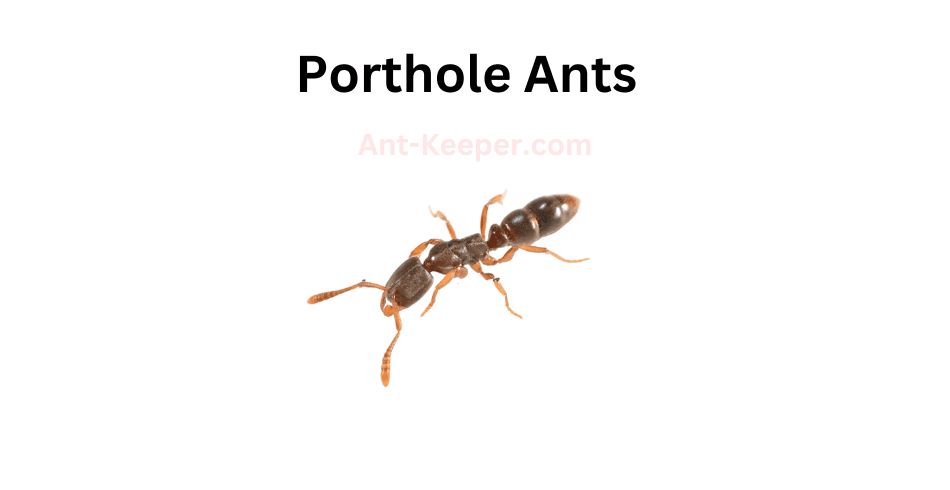
Porthole ants, also known as Temnothorax spp., are a genus of small ants that are commonly found in forested areas.
These ants are known for their unique nesting behavior, as they create their nests in small cavities or "portholes" in trees, rocks, or other natural structures.
Porthole ants are typically less than 5mm in length and have a dark brown or black coloration.
They are social insects and live in colonies that can range from a few dozen to several hundred individuals.
The colonies are typically led by a single queen, who is responsible for laying eggs and maintaining the colony's reproductive population.
One of the most interesting aspects of porthole ants is their nesting behavior.
Unlike many other ant species, porthole ants do not create large underground nests.
Instead, they seek out small cavities in natural structures and use them as their nesting sites.
These cavities can be as small as a few millimeters in diameter and are often located high up in trees or on rocky outcroppings.
Porthole ants are also known for their ability to adapt to changing environmental conditions.
They are able to quickly relocate their nests if their current nesting site becomes unsuitable due to factors such as flooding or predation.
This adaptability allows them to thrive in a variety of habitats, from temperate forests to arid deserts.
Overall, porthole ants are a fascinating and unique species of ant that have adapted to their environment in a variety of ways.
Their nesting behavior and adaptability make them an important species to study for understanding the ecology of forested areas.
8) Vampire Ants, Stigmatomma
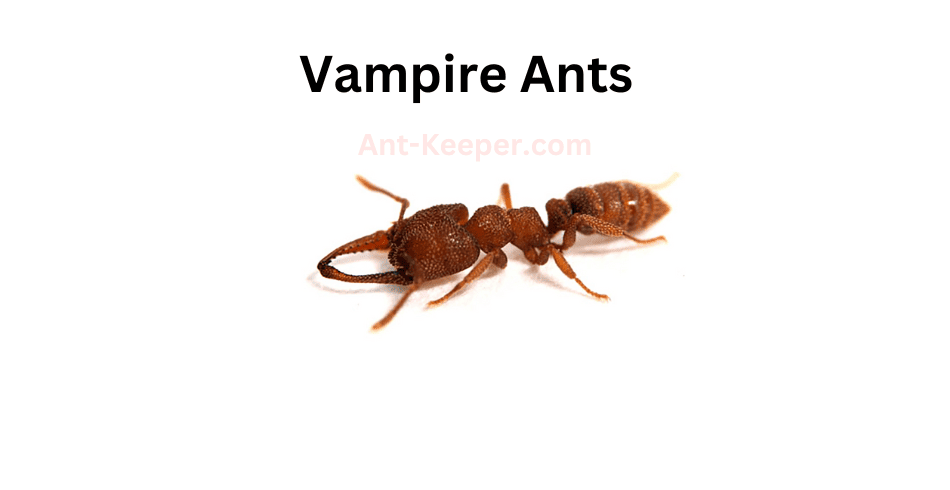
Vampire ants, also known as blood-sucking ants, are a species of ants that feed on the blood of other insects.
These ants are known for their unique feeding behavior, which involves biting into the exoskeleton of their prey and then sucking out their blood.
Vampire ants are typically found in tropical and subtropical regions, where they live in colonies of up to several thousand individuals.
They are known for their aggressive behavior and will attack other insects, including larger prey such as grasshoppers and caterpillars.
One of the most interesting aspects of vampire ants is their ability to adapt to their environment.
In some cases, these ants have been known to feed on the blood of their own colony members when other sources of food are scarce.
Vampire ants are also known for their unique physical characteristics.
They have long, curved mandibles that are used to bite into the exoskeleton of their prey.
They also have specialized mouthparts that allow them to suck out the blood of their victims.
Despite their aggressive behavior and blood-sucking tendencies, vampire ants play an important role in their ecosystem.
They help to control the populations of other insects and contribute to the overall balance of their environment.
Overall, vampire ants are a fascinating species of ants that have adapted to their environment in unique and interesting ways.
Their behavior and physical characteristics make them a subject of interest for scientists and nature enthusiasts alike.
9) Miniature Trap-Jaw Ants, Strumigenys
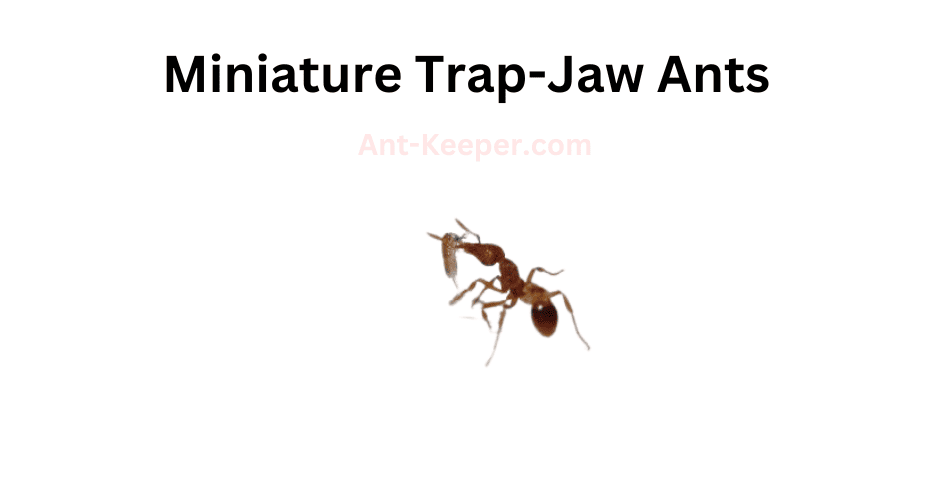
The Miniature Trap-Jaw Ants, scientifically known as Odontomachus sp., are a species of ants that belong to the family Formicidae.
These ants are known for their unique and powerful mandibles, which they use to capture prey and defend their colonies.
The Miniature Trap-Jaw Ants are relatively small in size, measuring only a few millimeters in length.
They have a dark brown or black coloration and a slender body shape.
Their most distinctive feature is their mandibles, which are elongated and can snap shut with incredible force.
These mandibles are used to capture prey, crush seeds, and defend the colony against predators.
The Miniature Trap-Jaw Ants are found in a variety of habitats, including forests, grasslands, and deserts.
They are known to be active during the day and are often seen foraging for food.
These ants are omnivorous and feed on a variety of food sources, including insects, nectar, and seeds.
The Miniature Trap-Jaw Ants are social insects and live in colonies that can range in size from a few dozen to several thousand individuals.
The colony is typically led by a queen, who is responsible for laying eggs and maintaining the colony's population.
The workers are responsible for foraging, caring for the young, and defending the colony.
Overall, the Miniature Trap-Jaw Ants are fascinating insects that have evolved unique adaptations to survive in their environment.
Their powerful mandibles and social behavior make them an important part of many ecosystems.
10) Tapinoma

Tapinoma is a genus of ants that belongs to the family Formicidae.
The species Tapinoma is a small ant that measures about 2-3 mm in length.
They are commonly found in urban and suburban areas, and are known to invade homes and buildings in search of food and shelter.
Tapinoma ants are light brown in color and have a slender body with long legs.
They have a distinctively shaped head that is wider than their thorax, and they possess a pair of antennae that are bent at a right angle.
These ants are known for their ability to form large colonies, which can consist of thousands of individuals.
Tapinoma ants are omnivorous and feed on a variety of food sources, including insects, nectar, and honeydew.
They are also known to scavenge for food in garbage cans and other waste areas.
These ants are attracted to sweet and sugary substances, and will often invade kitchens and pantries in search of food.
Tapinoma ants are not known to be aggressive towards humans, but they can become a nuisance when they invade homes and buildings.
They are known to build their nests in wall voids, under floors, and in other hidden areas.
If left unchecked, these ants can cause damage to structures and can contaminate food sources.
Overall, Tapinoma ants are a common pest in many parts of the world.
While they are not harmful to humans, they can be a nuisance when they invade homes and buildings.
Proper pest control measures can help to prevent infestations and keep these ants at bay.
11) Rover Ants, Brachymyrmex Obscurior
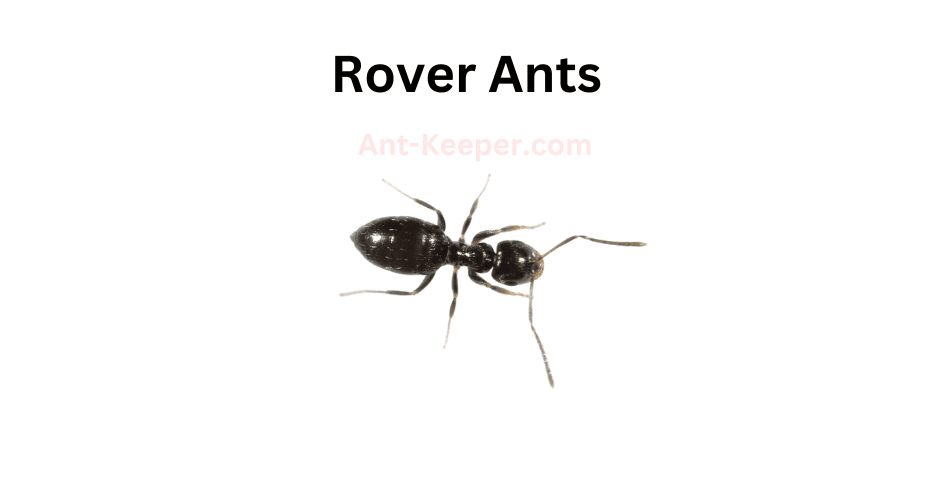
Rover ants, also known as Brachymyrmex spp., are a species of small, dark-colored ants that are commonly found in urban and suburban areas.
These ants are known for their ability to quickly move their nests from one location to another, hence their name "rover ants."
Rover ants are typically between 1.5 and 2.5 millimeters in length and have a dark brown or black coloration.
They have a slender body with a distinct waist and long, thin legs.
These ants are known for their aggressive behavior towards other ant species and will often invade and take over their nests.
Rover ants are omnivorous and will feed on a variety of food sources, including insects, sweets, and plant material.
They are also known to be attracted to human food and can become a nuisance in homes and other buildings.
One unique characteristic of rover ants is their ability to form "supercolonies." These supercolonies can consist of multiple nests and can span large areas.
This behavior allows rover ants to quickly adapt to changing environments and find new food sources.
Overall, rover ants are a common and adaptable species that can be found in many different environments.
While they can be a nuisance in homes and other buildings, they play an important role in the ecosystem as scavengers and predators of other insects.
12) Emerys Sneaking Ants, Cardiocondyla Emeryi
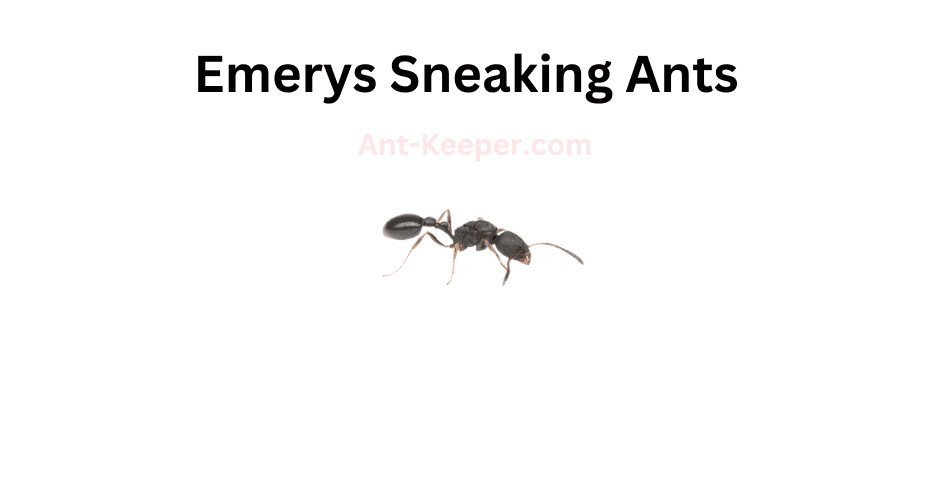
Emery's Sneaking Ants, also known as Pheidole emeryi, are a species of ant that belong to the family Formicidae.
These ants are known for their ability to sneak into other ant colonies and steal their resources without being detected.
Emery's Sneaking Ants are small in size, measuring only 2-3 mm in length.
They have a dark brown or black coloration and a distinctively large head in proportion to their body.
Their mandibles are also relatively large, which allows them to carry larger food items back to their own colony.
These ants are primarily found in forested areas and are known to be opportunistic feeders.
They will consume a variety of food sources, including other insects, nectar, and honeydew.
However, they are also known to steal food from other ant colonies, which is where they get their name.
Emery's Sneaking Ants have a unique strategy for infiltrating other ant colonies.
They will send out scouts to locate a nearby colony and then send in a small group of worker ants to steal food.
These worker ants will use their small size and agility to sneak past the guards of the other colony and steal food without being detected.
Despite their sneaky behavior, Emery's Sneaking Ants are not considered harmful to other ant colonies.
They do not engage in aggressive behavior and are not known to cause any significant damage to other ant colonies.
However, they are still an interesting species to study and observe in their natural habitat.
13) Sneaking Ants, Cardiocondyla Minutior
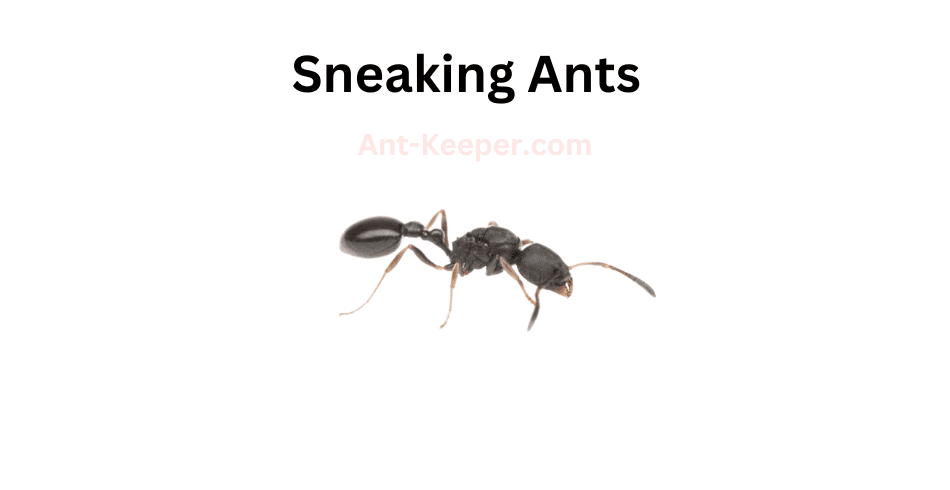
Sneaking Ants, also known as Camponotus obscuripes, are a species of ant that are commonly found in forested areas.
These ants are known for their ability to move quietly and quickly, making them difficult to detect.
Sneaking Ants are typically black or dark brown in color and range in size from 5 to 12 millimeters in length.
They have a distinctive, flattened head and a narrow waist, which helps them to navigate through tight spaces.
One of the most interesting aspects of Sneaking Ants is their behavior.
These ants are known for their ability to sneak up on other insects and steal their food.
They are also known to raid the nests of other ant species, taking their eggs and larvae back to their own colony to raise as their own.
Sneaking Ants are omnivorous, meaning they eat both plant and animal matter.
They have been observed feeding on nectar, honeydew, and small insects.
They are also known to scavenge for food, often taking advantage of the leftovers from other insects.
In terms of reproduction, Sneaking Ants have a unique system.
The colony is typically led by a single queen, who is responsible for laying eggs.
However, there are also a number of worker ants who are capable of laying eggs as well.
These eggs are typically unfertilized and produce male ants, which are used for mating purposes.
Overall, Sneaking Ants are a fascinating species with unique behaviors and adaptations.
Their ability to move quietly and quickly makes them a formidable predator, and their omnivorous diet allows them to thrive in a variety of environments.
14) Sneaking Ants, Cardiocondyla Venustula

Sneaking Ants, also known as Camponotus obscuripes, are a species of ant that are commonly found in forested areas.
These ants are known for their ability to move quietly and quickly, making them difficult to detect.
Sneaking Ants are typically black or dark brown in color and range in size from 5 to 12 millimeters in length.
They have a distinctive, flattened head and a narrow waist, which helps them to navigate through tight spaces.
One of the most interesting aspects of Sneaking Ants is their behavior.
These ants are known for their ability to sneak up on other insects and steal their food.
They are also known to raid the nests of other ant species, taking their eggs and larvae back to their own colony to raise as their own.
Sneaking Ants are omnivorous, meaning they eat both plant and animal matter.
They have been observed feeding on nectar, honeydew, and small insects.
They are also known to scavenge for food, often taking advantage of the leftovers from other insects.
In terms of reproduction, Sneaking Ants have a unique system.
The colony is typically led by a single queen, who is responsible for laying eggs.
However, there are also a number of worker ants who are capable of laying eggs as well.
These eggs are typically unfertilized and produce male ants, which are used for mating purposes.
Overall, Sneaking Ants are a fascinating species with unique behaviors and adaptations.
Their ability to move quietly and quickly makes them a formidable predator, and their omnivorous diet allows them to thrive in a variety of environments.
15) Sneaking Ants, Cardiocondyla Wroughtonii

Sneaking Ants, also known as Camponotus obscuripes, are a species of ant that are commonly found in forested areas.
These ants are known for their ability to move quietly and quickly, making them difficult to detect.
Sneaking Ants are typically black or dark brown in color and range in size from 5 to 12 millimeters in length.
They have a distinctive, flattened head and a narrow waist, which helps them to navigate through tight spaces.
One of the most interesting aspects of Sneaking Ants is their behavior.
These ants are known for their ability to sneak up on other insects and steal their food.
They are also known to raid the nests of other ant species, taking their eggs and larvae back to their own colony to raise as their own.
Sneaking Ants are omnivorous, meaning they eat both plant and animal matter.
They have been observed feeding on nectar, honeydew, and small insects.
They are also known to scavenge for food, often taking advantage of the leftovers from other insects.
In terms of reproduction, Sneaking Ants have a unique system.
The colony is typically led by a single queen, who is responsible for laying eggs.
However, there are also a number of worker ants who are capable of laying eggs as well.
These eggs are typically unfertilized and produce male ants, which are used for mating purposes.
Overall, Sneaking Ants are a fascinating species with unique behaviors and adaptations.
Their ability to move quietly and quickly makes them a formidable predator, and their omnivorous diet allows them to thrive in a variety of environments.
16) Crypt Ants, Hypoponera Opaciceps

Crypt ants, also known as fungus-growing ants, are a group of ants that cultivate fungi for food.
They are found in various habitats, including forests, grasslands, and deserts.
Crypt ants are known for their unique nesting behavior, as they construct underground chambers to house their fungal gardens.
These ants have a symbiotic relationship with the fungi they cultivate.
The ants provide the fungi with a suitable environment for growth, while the fungi provide the ants with a source of food.
The ants also protect their fungal gardens from other insects and parasites.
Crypt ants are social insects, living in colonies that can range from a few dozen to several thousand individuals.
The colonies are organized into castes, with the queen being the largest and most important member.
The queen is responsible for laying eggs, while the workers are responsible for tending to the fungal gardens and caring for the young.
One interesting aspect of crypt ants is their ability to create "satellite" nests.
These nests are smaller chambers located near the main nest, and they serve as storage areas for food and as a place for the queen to lay eggs.
The satellite nests are connected to the main nest by underground tunnels, allowing the ants to move between them.
Overall, crypt ants are fascinating insects that have developed a unique way of obtaining food.
Their symbiotic relationship with fungi and their complex nesting behavior make them an important species to study in the field of entomology.
17) Crypt Ants, Hypoponera Opacior

Crypt ants, also known as fungus-growing ants, are a group of ants that cultivate fungi for food.
They are found in various habitats, including forests, grasslands, and deserts.
Crypt ants are known for their unique nesting behavior, as they construct underground chambers to house their fungal gardens.
These ants have a symbiotic relationship with the fungi they cultivate.
The ants provide the fungi with a suitable environment for growth, while the fungi provide the ants with a source of food.
The ants also protect their fungal gardens from other insects and parasites.
Crypt ants are social insects, living in colonies that can range from a few dozen to several thousand individuals.
The colonies are organized into castes, with the queen being the largest and most important member.
The queen is responsible for laying eggs, while the workers are responsible for tending to the fungal gardens and caring for the young.
One interesting aspect of crypt ants is their ability to create "satellite" nests.
These nests are smaller chambers located near the main nest, and they serve as storage areas for food and as a place for the queen to lay eggs.
The satellite nests are connected to the main nest by underground tunnels, allowing the ants to move between them.
Overall, crypt ants are fascinating insects that have developed a unique way of obtaining food.
Their symbiotic relationship with fungi and their complex nesting behavior make them an important species to study in the field of entomology.
18) Urban Alate Ants, Hypoponera Punctatissima
The Urban Alate Ants are a species of ants that are commonly found in urban areas.
They are known for their ability to fly and are often seen swarming around streetlights and other sources of light at night.
These ants are part of the Formicidae family and are classified as alates, which means they have wings and are capable of reproducing.
The Urban Alate Ants are typically small in size, measuring between 2-3mm in length.
They have a dark brown or black coloration and a slender body shape.
These ants are social insects and live in large colonies that can consist of thousands of individuals.
The diet of the Urban Alate Ants consists of a variety of food sources, including nectar, honeydew, and other sugary substances.
They are also known to feed on insects and other small invertebrates.
One of the most interesting aspects of the Urban Alate Ants is their reproductive behavior.
The alates, or winged ants, are the reproductive members of the colony.
During the mating season, the alates will swarm in large numbers and mate in mid-air.
After mating, the males will die, and the females will shed their wings and search for a suitable location to start a new colony.
Overall, the Urban Alate Ants are a fascinating species of ants that have adapted well to living in urban environments.
Their ability to fly and reproduce in large numbers makes them a common sight in many cities around the world.
19) Crypt Ants, Hypoponera Ragusai

Crypt ants, also known as fungus-growing ants, are a group of ants that cultivate fungi for food.
They are found in various habitats, including forests, grasslands, and deserts.
Crypt ants are known for their unique nesting behavior, as they construct underground chambers to house their fungal gardens.
These ants have a symbiotic relationship with the fungi they cultivate.
The ants provide the fungi with a suitable environment for growth, while the fungi provide the ants with a source of food.
The ants also protect their fungal gardens from other insects and parasites.
Crypt ants are social insects, living in colonies that can range from a few dozen to several thousand individuals.
The colonies are organized into castes, with the queen being the largest and most important member.
The queen is responsible for laying eggs, while the workers are responsible for tending to the fungal gardens and caring for the young.
One interesting aspect of crypt ants is their ability to create "satellite" nests.
These nests are smaller chambers located near the main nest, and they serve as storage areas for food and as a place for the queen to lay eggs.
The satellite nests are connected to the main nest by underground tunnels, allowing the ants to move between them.
Overall, crypt ants are fascinating insects that have developed a unique way of obtaining food.
Their symbiotic relationship with fungi and their complex nesting behavior make them an important species to study in the field of entomology.
20) Black Garden Ants, Lasius Niger
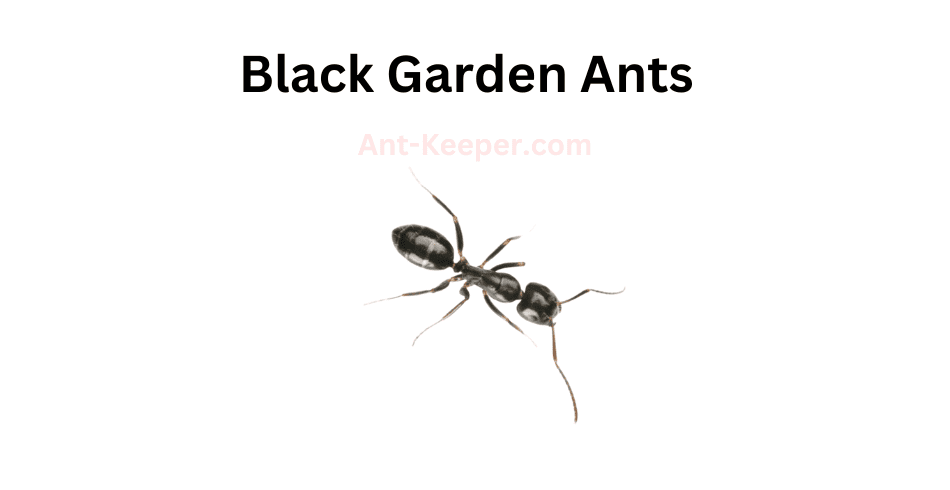
The Black Garden Ant, also known as Lasius niger, is a common species of ant found in many parts of the world.
These ants are typically black or dark brown in color and range in size from 2.5 to 4 mm in length.
Black Garden Ants are social insects that live in large colonies, which can contain thousands of individuals.
The colony is typically led by a queen ant, who is responsible for laying eggs and producing new workers.
The workers are responsible for foraging for food, caring for the young, and defending the colony from predators.
These ants are omnivorous and will eat a variety of foods, including insects, nectar, and honeydew.
They are also known to farm aphids, which they protect and feed in exchange for the sweet honeydew they produce.
Black Garden Ants are important members of their ecosystem, as they help to aerate soil and control populations of other insects.
However, they can also be considered pests when they invade homes and gardens in search of food and shelter.
Overall, the Black Garden Ant is a fascinating and important species of ant that plays a vital role in many ecosystems around the world.
21) Trailing Pharaoh And Timid Ants, Monomorium Liliuokalanii

The Trailing Pharaoh ant, also known as the Monomorium pharaonis, is a small, reddish-brown ant species that is commonly found in urban areas.
These ants are known for their ability to form large colonies, which can consist of thousands of individuals.
One interesting behavior of the Trailing Pharaoh ant is their tendency to trail behind other ants.
This behavior is thought to be a form of communication, as the trailing ants are able to follow the scent trail left by the leading ants.
This behavior is also used to locate food sources, as the trailing ants are able to follow the trail to the source of the food.
In contrast to the bold behavior of the Trailing Pharaoh ant, the Timid ant, also known as the Temnothorax species, is a much more cautious species.
These ants are small and brown, and are often found in wooded areas.
They are known for their timid behavior, and will often retreat into their nests when threatened.
Despite their timid nature, the Timid ant is still able to form large colonies.
They are also known for their ability to adapt to changing environments, and can be found in a variety of habitats, including forests, meadows, and even urban areas.
Overall, both the Trailing Pharaoh ant and the Timid ant are fascinating species that demonstrate unique behaviors and adaptations.
By studying these ants, scientists can gain a better understanding of the complex social behaviors and ecological roles of ants in their respective environments.
22) Pharaoh Ants, Monomorium Pharaonis
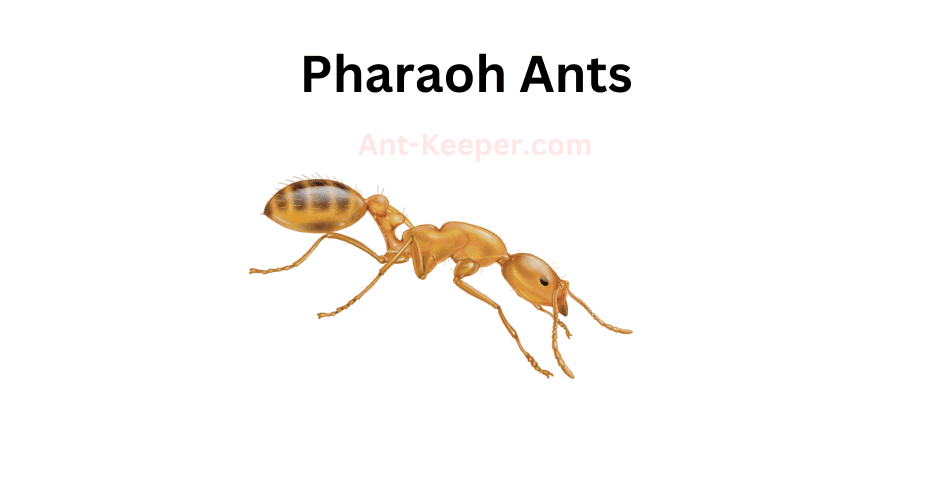
Pharaoh ants, scientifically known as Monomorium pharaonis, are small, yellowish-brown ants that measure about 2 mm in length.
They are commonly found in indoor environments such as homes, hospitals, and commercial buildings.
Pharaoh ants are known for their ability to form large colonies with multiple queens.
These colonies can contain thousands of workers and can quickly infest a building.
They are also known for their ability to adapt to changing environments and can easily relocate their nests if disturbed.
Pharaoh ants are omnivorous and feed on a variety of foods including sweets, meats, and other insects.
They are also known to feed on human fluids such as blood and wound exudates.
Due to their small size and ability to hide in small crevices, pharaoh ants can be difficult to control.
They are known to be resistant to many common insecticides and can quickly rebound after treatment.
Pharaoh ants are also a concern in healthcare settings as they can transmit diseases such as salmonella and staphylococcus.
They can also contaminate sterile equipment and supplies.
Overall, pharaoh ants are a common pest in indoor environments and can be difficult to control.
It is important to seek professional pest control services to effectively manage infestations.
23) Crazy Ants, Nylanderia Bourbonica

Crazy ants, also known as Nylanderia fulva, are a species of ant that belong to the family Formicidae.
They are small in size, measuring only about 2.2 to 3 mm in length, and are reddish-brown in color.
These ants are known for their erratic and unpredictable behavior, hence the name "crazy ants."
Crazy ants are native to South America, but have since spread to other parts of the world, including North America, Asia, and Australia.
They are highly adaptable and can thrive in a variety of environments, including urban areas, forests, and grasslands.
One of the most notable characteristics of crazy ants is their ability to form large colonies with multiple queens.
This allows them to quickly establish themselves in new areas and outcompete other ant species.
Crazy ants are also known for their aggressive behavior towards other insects and animals, including humans.
In addition to their aggressive behavior, crazy ants are also known for their ability to cause damage to electrical equipment.
They are attracted to electrical currents and can easily short-circuit electronics, causing damage and potentially starting fires.
Despite their small size, crazy ants are a formidable species that can have a significant impact on their environment.
As they continue to spread to new areas, it is important to monitor their behavior and take steps to control their populations in order to minimize their impact on ecosystems and human infrastructure.
24) Ochetellus Glaber
Ochetellus Glaber, commonly known as the smooth ant, is a species of ant belonging to the family Formicidae.
These ants are small in size, measuring only about 2-3mm in length.
They have a shiny, smooth appearance due to the lack of hairs on their bodies.
The smooth ant is known for its aggressive behavior towards other ant species.
They are often found in large colonies, with a single queen leading the group.
These ants are omnivorous, feeding on a variety of food sources including insects, nectar, and honeydew.
One interesting characteristic of Ochetellus Glaber is their ability to form symbiotic relationships with other insects.
They are known to protect and care for aphids, in exchange for the sweet honeydew that the aphids produce.
The smooth ant is also known for its ability to adapt to different environments.
They can be found in a variety of habitats, including forests, grasslands, and urban areas.
They are able to survive in both hot and cold climates, making them a resilient species.
Overall, Ochetellus Glaber is a fascinating species of ant with unique characteristics and behaviors.
Their ability to form symbiotic relationships and adapt to different environments make them an important part of the ecosystem.
25) Longhorn Crazy Ants, Paratrechina Longicornis
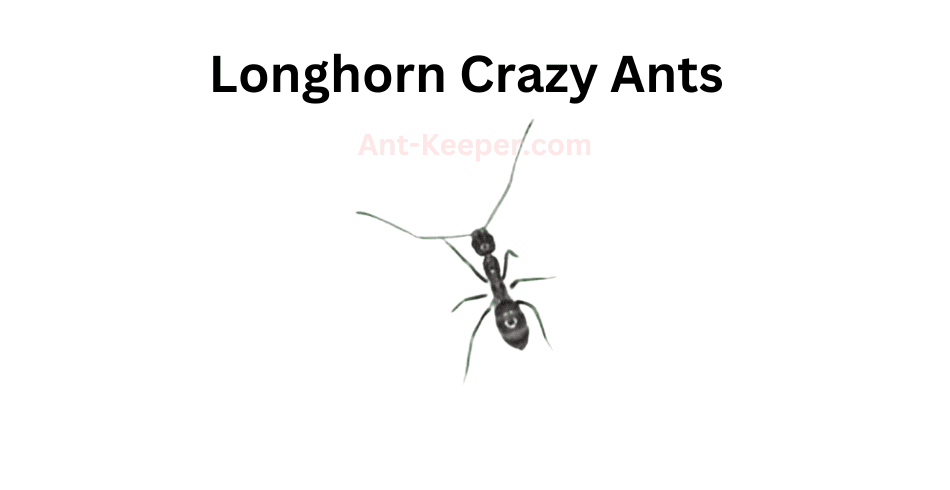
The Longhorn Crazy Ant (Paratrechina longicornis) is a small, dark brown ant species that is known for its erratic and unpredictable behavior.
These ants are typically found in warm, humid environments and are often found in urban areas, where they can be a nuisance to homeowners and businesses.
One of the most distinctive features of the Longhorn Crazy Ant is its long, slender antennae, which can be up to twice the length of its body.
These antennae are used to detect chemical signals from other ants and to navigate through their environment.
Longhorn Crazy Ants are omnivorous and will feed on a wide variety of foods, including insects, fruits, and sweet liquids.
They are also known to be scavengers, and will often invade other ant colonies to steal food and resources.
One of the most interesting aspects of the Longhorn Crazy Ant is its behavior.
These ants are known for their erratic movements and unpredictable behavior, which can make them difficult to control.
They are also known for their ability to form large, sprawling colonies that can quickly take over an area.
Despite their small size, Longhorn Crazy Ants can be a significant pest problem, particularly in urban areas.
They can invade homes and businesses, contaminate food, and cause damage to electrical equipment.
As a result, it is important to take steps to control these ants and prevent infestations from occurring.
26) Big Headed Ants, Pheidole Megacephala

Big Headed Ants, also known as Pheidole megacephala, are a species of ant that belong to the family Formicidae.
These ants are known for their distinctive large heads, which are used for defense and communication within their colonies.
Big Headed Ants are typically found in tropical and subtropical regions, where they build their nests in soil, leaf litter, and other organic matter.
They are omnivorous, feeding on a variety of insects, seeds, and other small organisms.
One of the most interesting aspects of Big Headed Ants is their social behavior.
They live in large colonies, with a queen ant at the center of the hierarchy.
The queen is responsible for laying eggs, while the other ants in the colony perform various tasks such as foraging for food, caring for the young, and defending the colony from predators.
Big Headed Ants are also known for their ability to displace other ant species in their habitats.
They are aggressive and have been known to attack and kill other ants, as well as compete with them for resources.
Despite their aggressive behavior, Big Headed Ants are not considered a major pest species.
However, their ability to displace other ant species and their potential impact on native ecosystems make them an important species to study and monitor.
27) Restless Ants, Plagiolepis Alluaudi
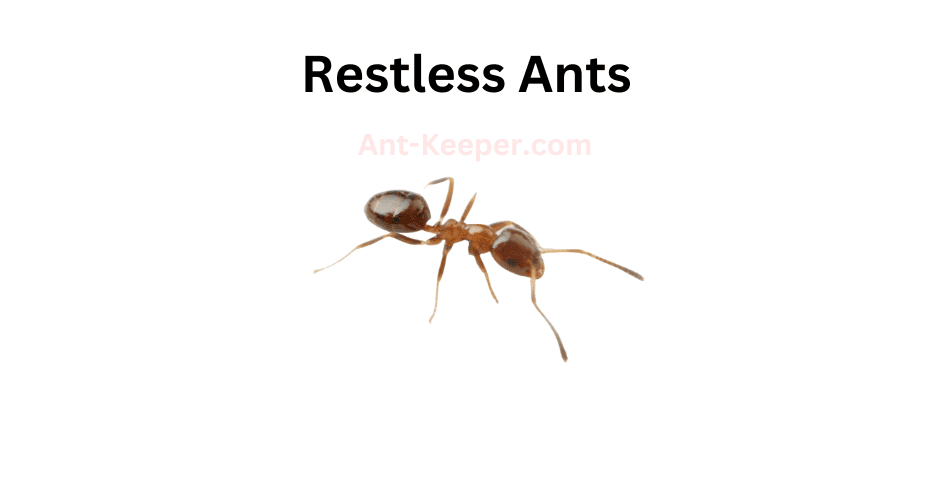
Restless Ants, also known as the Red Ants, are a species of ants that belong to the Formicidae family.
They are known for their highly active and restless behavior, constantly moving around in search of food and resources.
These ants are typically small in size, measuring around 2-3 mm in length.
They have a reddish-brown coloration and a slender body shape, with long legs and antennae.
Restless Ants are social insects, living in large colonies that can contain thousands of individuals.
Restless Ants are omnivorous, feeding on a variety of food sources including insects, fruits, and seeds.
They are also known to scavenge for food, often raiding the nests of other ant species to steal their resources.
One of the most interesting aspects of Restless Ants is their ability to adapt to changing environments.
They are able to quickly adjust their behavior and foraging patterns in response to changes in their surroundings, such as changes in temperature or the availability of food.
Restless Ants are also known for their aggressive behavior, particularly when defending their nests or resources.
They have powerful mandibles that they use to bite and defend themselves against predators or other ants.
Overall, Restless Ants are fascinating creatures that play an important role in their ecosystem.
Their highly active and adaptable behavior makes them a valuable species to study and understand.
28) Tropical Fire Ants, Solenopsis Geminata
The Tropical Fire Ant (Solenopsis geminata) is a species of ant that belongs to the family Formicidae.
These ants are known for their aggressive behavior and painful sting, which can cause severe allergic reactions in some individuals.
Tropical Fire Ants are typically reddish-brown in color and range in size from 2 to 6 millimeters in length.
They are commonly found in tropical and subtropical regions, where they build large nests in soil or under rocks.
These ants are omnivorous and feed on a variety of food sources, including insects, seeds, and nectar.
They are also known to tend to aphids and other insects for their honeydew excretions.
Tropical Fire Ants are highly territorial and will aggressively defend their nests against intruders.
They use their powerful mandibles to bite and their stingers to inject venom into their prey or attackers.
The venom of Tropical Fire Ants contains a mixture of alkaloids and proteins that can cause pain, swelling, and itching in humans.
In some cases, the venom can also cause anaphylaxis, a severe allergic reaction that can be life-threatening.
Despite their aggressive behavior and painful sting, Tropical Fire Ants play an important role in their ecosystem.
They help control the populations of other insects and contribute to soil health through their nest-building activities.
29) Miniature Trap-Jaw Ants, Strumigenys Emmae

The Miniature Trap-Jaw Ants, scientifically known as Odontomachus sp., are a species of ants that belong to the family Formicidae.
These ants are known for their unique and powerful mandibles, which they use to capture prey and defend their colonies.
The Miniature Trap-Jaw Ants are relatively small in size, measuring only a few millimeters in length.
They have a dark brown or black coloration and a slender body shape.
Their most distinctive feature is their mandibles, which are elongated and can snap shut with incredible force.
These mandibles are used to capture prey, crush seeds, and defend the colony against predators.
The Miniature Trap-Jaw Ants are found in a variety of habitats, including forests, grasslands, and deserts.
They are known to be active during the day and are often seen foraging for food.
These ants are omnivorous and feed on a variety of food sources, including insects, nectar, and seeds.
The Miniature Trap-Jaw Ants are social insects and live in colonies that can range in size from a few dozen to several thousand individuals.
The colony is typically led by a queen, who is responsible for laying eggs and maintaining the colony's population.
The workers are responsible for foraging, caring for the young, and defending the colony.
Overall, the Miniature Trap-Jaw Ants are fascinating insects that have evolved unique adaptations to survive in their environment.
Their powerful mandibles and social behavior make them an important part of many ecosystems.
30) Pale-Footed Ants, Technomyrmex Difficilis
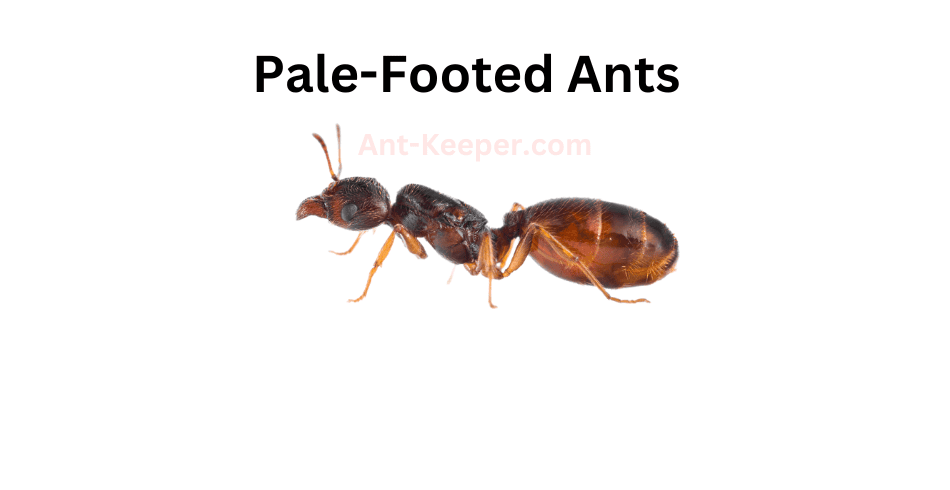
Pale-Footed Ants, also known as Pheidole pallidula, are a species of ant belonging to the family Formicidae.
These ants are typically small in size, measuring around 2-3mm in length, and are characterized by their pale yellowish-brown coloration and distinctive pale-colored feet.
Pale-Footed Ants are known for their highly organized social structure, which is divided into different castes including workers, soldiers, and reproductive individuals.
Workers are responsible for foraging for food, caring for the young, and maintaining the nest, while soldiers are tasked with defending the colony from predators and other threats.
One of the most interesting aspects of Pale-Footed Ant behavior is their ability to engage in "tandem running," a process in which two ants run together, with the follower using its antennae to track the movements of the leader.
This behavior is thought to help the ants navigate their environment more efficiently and locate food sources more quickly.
Pale-Footed Ants are also known for their unique feeding habits, which include a preference for sweet liquids such as nectar and honeydew.
They are also known to engage in trophallaxis, a process in which food is shared between members of the colony through mouth-to-mouth transfer.
Overall, Pale-Footed Ants are a fascinating species with a complex social structure and unique behaviors.
Their small size and inconspicuous appearance make them easy to overlook, but their importance in maintaining ecological balance and contributing to the overall health of their ecosystem should not be underestimated.
31) Pale-Footed Ants, Technomyrmex Vitiensis

Pale-Footed Ants, also known as Pheidole pallidula, are a species of ant belonging to the family Formicidae.
These ants are typically small in size, measuring around 2-3mm in length, and are characterized by their pale yellowish-brown coloration and distinctive pale-colored feet.
Pale-Footed Ants are known for their highly organized social structure, which is divided into different castes including workers, soldiers, and reproductive individuals.
Workers are responsible for foraging for food, caring for the young, and maintaining the nest, while soldiers are tasked with defending the colony from predators and other threats.
One of the most interesting aspects of Pale-Footed Ant behavior is their ability to engage in "tandem running," a process in which two ants run together, with the follower using its antennae to track the movements of the leader.
This behavior is thought to help the ants navigate their environment more efficiently and locate food sources more quickly.
Pale-Footed Ants are also known for their unique feeding habits, which include a preference for sweet liquids such as nectar and honeydew.
They are also known to engage in trophallaxis, a process in which food is shared between members of the colony through mouth-to-mouth transfer.
Overall, Pale-Footed Ants are a fascinating species with a complex social structure and unique behaviors.
Their small size and inconspicuous appearance make them easy to overlook, but their importance in maintaining ecological balance and contributing to the overall health of their ecosystem should not be underestimated.
32) Pavement Ants, Tetramorium Caldarium
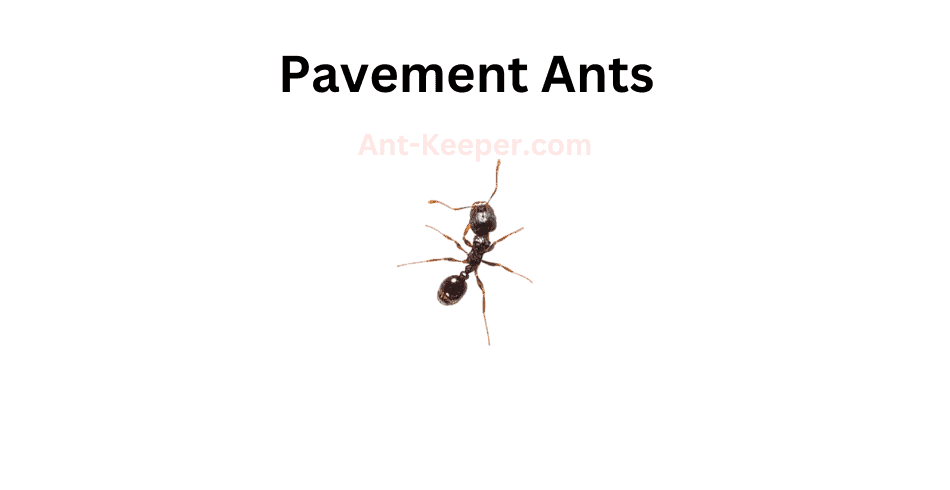
Pavement ants, also known as Tetramorium caespitum, are a species of ant that belong to the family Formicidae.
These ants are commonly found in urban and suburban areas, where they build their nests in cracks and crevices in pavement, sidewalks, and buildings.
Pavement ants are small in size, measuring between 2.5 to 4 mm in length.
They are typically dark brown or black in color, with lighter colored legs and antennae.
These ants are known for their aggressive behavior and will defend their nests fiercely against intruders.
Pavement ants are omnivorous, feeding on a variety of foods including insects, seeds, and sweet substances such as honeydew and nectar.
They are also known to scavenge for food in garbage cans and other waste areas.
Pavement ants are social insects, living in colonies that can range in size from a few hundred to several thousand individuals.
The colony is typically led by a queen ant, who is responsible for laying eggs and maintaining the colony.
Pavement ants are considered a nuisance pest, as they can invade homes and buildings in search of food and shelter.
They are also known to cause damage to pavement and other structures by excavating soil and creating tunnels.
Overall, pavement ants are a common and adaptable species of ant that play an important role in urban ecosystems.
While they may be a nuisance to humans, they are an important food source for many other animals and help to maintain the balance of the ecosystem.
33) Groove-Headed Fierce Ants, Tetramorium Simillimum
Groove-Headed Fierce Ants, also known as GFA, are a species of ants that belong to the Formicidae family.
They are known for their aggressive behavior and their ability to defend their colonies fiercely.
The name "groove-headed" comes from the distinct groove on their head that separates their eyes from their antennae.
GFAs are relatively small, measuring only about 3-5 millimeters in length.
They have a dark brown or black coloration and a slender body shape.
Their mandibles are long and sharp, which they use to capture prey and defend their colony.
These ants are social insects and live in large colonies that can contain up to several thousand individuals.
The colony is usually led by a queen ant, who is responsible for laying eggs and maintaining the colony's population.
The workers, which are sterile females, are responsible for foraging for food, caring for the young, and defending the colony.
GFAs are omnivorous and feed on a variety of food sources, including insects, nectar, and honeydew.
They are also known to scavenge for dead animals and consume plant material.
One of the most notable characteristics of GFAs is their aggressive behavior.
They are known to attack and kill other insects, including other ant species.
When threatened, they will swarm and bite their attacker, injecting formic acid into their wound.
This acid can cause pain and irritation to the attacker, and in some cases, can even be lethal.
Overall, GFAs are a fascinating species of ants that exhibit unique behaviors and characteristics.
Their fierce nature and ability to defend their colony make them an important part of their ecosystem.
34) Singapore Ants, Trichomyrmex Destructor
The Singapore ant, also known as the Asian needle ant, is a species of ant that belongs to the Formicidae family.
These ants are known for their aggressive behavior and are considered to be a nuisance pest in many areas.
They are typically found in urban and suburban environments, where they can be seen foraging for food and building their nests.
The Singapore ant is a small ant, measuring only a few millimeters in length.
They are typically black or dark brown in color, with a slender body and long legs.
These ants are known for their sharp stingers, which they use to defend themselves and their colony.
The Singapore ant is a social insect, living in large colonies that can contain thousands of individuals.
They are organized into a caste system, with workers, soldiers, and a queen.
The workers are responsible for foraging for food, caring for the young, and maintaining the nest.
The soldiers are larger and more aggressive, and are responsible for defending the colony from predators.
These ants are omnivorous, feeding on a variety of foods including insects, fruits, and sweet substances.
They are known for their ability to adapt to different environments, and can be found in a variety of habitats including forests, grasslands, and urban areas.
Despite their small size, the Singapore ant can be a significant pest in urban areas.
They are known for their aggressive behavior and can sting humans and pets if provoked.
They can also damage crops and invade homes in search of food.
Overall, the Singapore ant is a fascinating species of ant that is well adapted to urban environments.
While they can be a nuisance pest, they play an important role in the ecosystem and are an important part of the food chain.
Check Out Some Of Our Other Ants By Location Posts
| Types Of Ants In Vanuatu | Vanuatu, a small island nation located in the South Pacific Ocean, is a tropical paradise with a unique and diverse environment. The country is made ... |
| Types Of Ants In Nayarit, Mexico | Nayarit, a state located on the Pacific coast of Mexico, is a region known for its diverse and unique environment. The state is home to ... |
| Types Of Ants In Western New Guinea, Indonesia | Western New Guinea, also known as West Papua, is a region located in the eastern part of Indonesia. This vast and diverse region is home ... |
| Types Of Ants In Ghana | Ghana, located in West Africa, is a country known for its diverse wildlife and unique environmental features. The region is characterized by a tropical climate, ... |
| Types Of Ants In Victoria, Australia | Victoria, Australia is a region located in the southeastern part of the country. It is known for its diverse and unique environment, which includes a ... |
